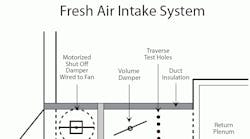Adding fresh air to a heating or cooling system accomplishes two primary Indoor Air Quality (IAQ) goals: First, it controls building pressures and secondly, it increases IAQ by diluting polluted or stale indoor air. Select to view Fresh Air Intake System model
Outside air enters the system through a roof or sidewall vent inlet that collects air from a clean outside location. The air is pulled into the system through a filter, into a duct connected to the return plenum. Smaller systems use the negative pressure from the air handler fan to move outside air. Outside air mixes with the return air, and then is dispersed evenly throughout the building via the supply duct system.
The attached drawing shows additional accessories that are included in a fresh air system. Each fresh air duct should contain a damper to control the airflow volume. Another option is a motorized shutoff damper that will seal the duct from outside air when the blower motor isn’t running. Since these ducts carry unconditioned outside air, insulation should be added to the exterior of the ducting to contain the hot or cold air and prevent condensation.
Since fresh air normally enters the duct before reaching the fan, the volume of return air being pulled from the building will be less than the supply air entering the building. If there is adequate outside air, this will normally cause a positive pressure in the building.
Positive pressure reduces infiltration of outside air from undesirable locations and prevents irritants and other pollutants from entering the building. This control of infiltration reduces heat loss or gain, and offsets the cost of heating or cooling outside air.
Adding fresh air into a building has other benefits. As it pressurizes a building, some of the indoor air is “exhausted”. This dilutes existing air with fresh air and forces out a percentage of the indoor pollutants with each air change. If there are combustion appliances in the building and combustion air is being pulled from outside the building, the outside air will act as combustion air for the appliances.
A supply register can also be cut into the supply plenum near the equipment to pressurize the mechanical room. This assures adequate combustion air for the burners and will normally increase the flue draft pressure to assure that the furnace or other combustion appliances will have adequate draft.
Rob “Doc” Falke serves the industry as president of National Comfort Institute a training company specializing in measuring, rating, improving and verifying HVAC system performance. If you're an HVAC contractor or technician interested in zoning system balancing procedure, contact Doc at or call him at 800-633-7058. Go to NCI’s website at www.nationalcomfortinstitute.com for free information, technical articles and downloads.
Latest from Archive
Latest from Archive
2019 Leaders in HVACR/Hydronics Innovations
Jan. 8, 2019
Solve Crawlspace Moisture Problems
May 18, 2017
Assembling a Contractor’s Business Bean Team
May 17, 2017








